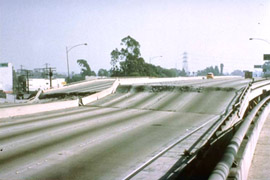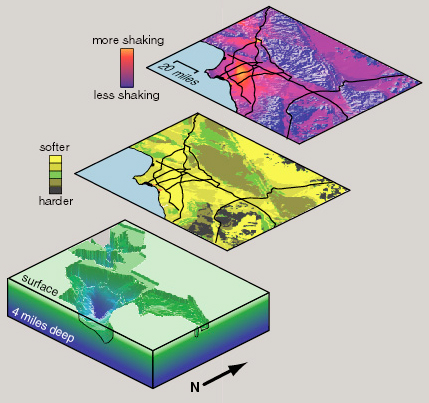|
On January 17, 1994, the Los Angeles region
was struck by the magnitude 6.7 Northridge earthquake, which
killed 57 people and caused more than $20 billion in damage.
The potential for damage in future earthquakes in southern California
is even greater. A Federal Emergency Management Agency (FEMA)
report issued in September 2000 estimated that southern California
accounts for 50% of the Nation's earthquake risk and that Los
Angeles County alone represents 25% of the total risk.
Most earthquake fatalities and damage occur
when buildings and other structures fail during violent shaking
caused by seismic waves, which travel through the ground from
the rupturing fault like the ripples from a pebble dropped into
a pond. The intensity of shaking depends on the quake magnitude
(size of the pebble) and distance from the fault (ripples get
smaller as they radiate outward). However, the radiation of seismic
waves is much more complex than the steady progression of circular
ripples in a pond. One reason is that the Earth's crust is not
homogeneous like water, but rather a complex mixture of rocks
and sediments of varying types that respond to shaking in different
ways. In a single earthquake, the shaking at one site can easily
be 10 times stronger than at a neighboring site, even when their
distance from the ruptured fault is the same.
In 1995, the Southern California Earthquake
Center (SCEC), a consortium of universities and the U.S. Geological
Survey (USGS) funded by the National Science Foundation and the
USGS, commissioned a working group of more than 20 scientists
and engineers to determine which areas of southern California
are likely to experience amplified levels of earthquake shaking
(that is, higher than other sites at the same distance from the
fault rupture). Their results are published in a December 2000
special issue of the Bulletin of the Seismological Society of
America.
 This section of the Santa Monica
Freeway was severely damaged when the Los Angeles region was
struck by the 1994 Northridge earthquake, the costliest quake
in U.S. history. However, freeways of similar construction even
closer to the source of the quake went unscathed. The Santa Monica
Freeway was damaged because the ground beneath it amplified the
shaking, causing the freeway to fail. (U.S. Geological Survey
photograph by Mehmet Çelebi.) This section of the Santa Monica
Freeway was severely damaged when the Los Angeles region was
struck by the 1994 Northridge earthquake, the costliest quake
in U.S. history. However, freeways of similar construction even
closer to the source of the quake went unscathed. The Santa Monica
Freeway was damaged because the ground beneath it amplified the
shaking, causing the freeway to fail. (U.S. Geological Survey
photograph by Mehmet Çelebi.) |
Two Characteristics
That Amplify Earthquake Shaking
By combining observations from past earthquakes
with computer-based predictions, the SCEC working group quantified
how levels of ground shaking in southern California are modified
by various characteristics of local geology. The two found to
be most important are the softness of the ground at a site and
the total thickness of sediments below a site. Although scientists
already knew that ground types of different softness had different
levels of shaking relative to each other, the SCEC study is the
first that has assigned numerical values to these effects on
such a broad scale.
Softness of the ground
at a site- Southern California
has a diverse landscape, from spectacular mountain ranges of
hard, crystalline rocks to low-lying valleys filled with softer,
sedimentary layers. Seismic waves travel faster through hard
rocks than through softer rocks and sediments. As the waves pass
from harder to softer rocks and slow down, they must get bigger
in amplitude to carry the same amount of energy. Thus, shaking
tends to be stronger at sites with softer surface layers, where
seismic waves move more slowly. As part of an independent study
published in the December 2000 report, the California Division
of Mines and Geology (CDMG) created a State-wide map showing
the wave speed in the shallowest 30 meters (100 feet) of the
Earth's crust. The SCEC working group then verified the CDMG
map for southern California by comparing and correlating these
classifications with the actual shaking observed during southern
California earthquakes. This calibration helped quantify the
increase in shaking expected from near-surface geology in future
earthquakes throughout the region.
Total thickness of sediments
below a site- The
sediment-filled valleys of southern California, with their relatively
flat terrain and fertile soil, are attractive locations for human
settlement. In an earthquake, however, as the thickness of sediment
increases, so too does the amount of shaking. The SCEC study
developed a new map of the depth and shape of sedimentary basins
in southern California and quantified the effect of basin depth
on earthquake shaking. For example, shaking levels double from
the edge of the Los Angeles Basin, where the sediments are thin,
to the middle of the basin, where sediments reach a thickness
of more than 6 kilometers (4 miles).
Pattern of Shaking Varies
From Earthquake to Earthquake
The two characteristics identified in the
SCEC study can explain some, but not all, of the variations in
earthquake shaking at specific sites. Preliminary computer simulations
of how seismic waves travel outward from fault ruptures (see
images below) indicate that there will be "hotspots"
of anomalous shaking unique to each earthquake. These hotspots
depend on specific details of the earthquake, such as orientation
of the fault, irregularities of the rupturing fault surface,
and scattering of waves as they bounce off subsurface structures.
Useful prediction of these effects will require more comprehensive
computer simulations of potential earthquakes on a case-by-case
basis. This is the goal of a concerted, interdisciplinary effort
by SCEC and USGS scientists.
The USGS and CDMG, working with SCEC researchers,
are producing practical tools that earthquake engineers, insurance
companies, and emergency-management officials can use to prepare
for the shaking-amplification patterns identified in the new
SCEC report. These tools will not only help to save lives and
protect property in future quakes in southern California but
will also help to improve understanding of seismic hazards in
other earthquake-prone regions of the United States.
|

 This section of the Santa Monica
Freeway was severely damaged when the Los Angeles region was
struck by the 1994 Northridge earthquake, the costliest quake
in U.S. history. However, freeways of similar construction even
closer to the source of the quake went unscathed. The Santa Monica
Freeway was damaged because the ground beneath it amplified the
shaking, causing the freeway to fail. (U.S. Geological Survey
photograph by Mehmet Çelebi.)
This section of the Santa Monica
Freeway was severely damaged when the Los Angeles region was
struck by the 1994 Northridge earthquake, the costliest quake
in U.S. history. However, freeways of similar construction even
closer to the source of the quake went unscathed. The Santa Monica
Freeway was damaged because the ground beneath it amplified the
shaking, causing the freeway to fail. (U.S. Geological Survey
photograph by Mehmet Çelebi.)



